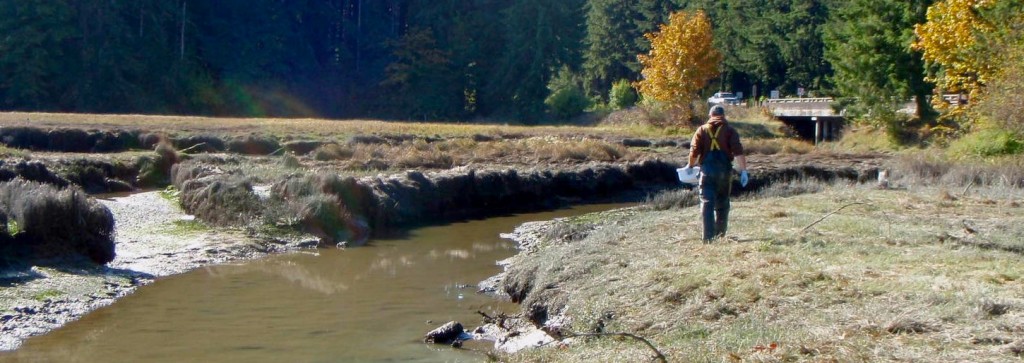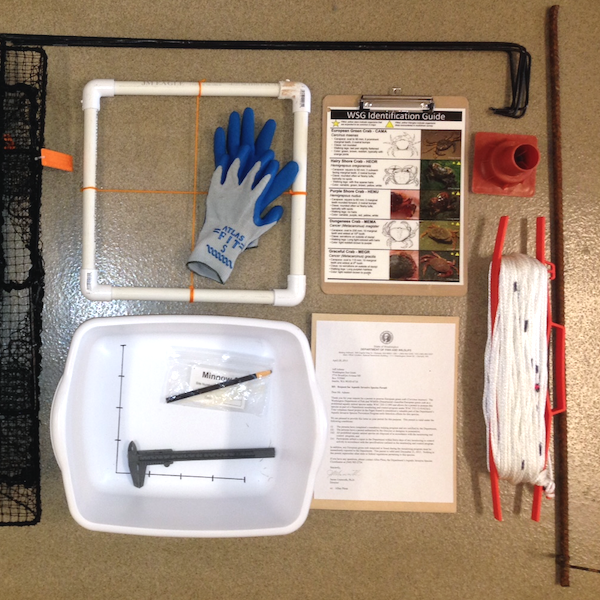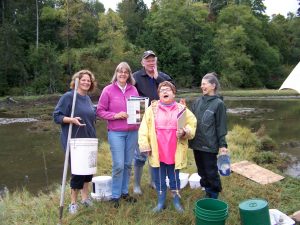Crab Team estimates that there are more than 400 sites in Puget Sound, the Strait of Juan de Fuca, and the San Juan Islands possessing at least one suitable habitat feature for European green crabs.
That is many more than we could hope to monitor by ourselves. You can participate by keeping an eye out for green crabs and by helping us expand upon what we know about the community of organisms living in our regional salt marshes and pocket estuaries. Simply look for invasive green crabs next time you stroll along your favorite beach – or get your boots muddy and volunteer with us!
Eyes on the Beach
The easiest way to help is to keep your eyes peeled for European green crabs any time you visit the beach. Familiarize yourself with how to identify this species, and distinguish it from similar native species on our Crab Identification page. We have many native species that are similar in color and size to this species, and are often mistaken for European green crab. So careful attention is required.
You might find live crabs or just a crab molt (shed shell). In fact, when the European green crab first arrived in the coastal embayments of Washington, the very first reports were not of live crabs, but of molted shells. Like snakes, crab shed their “skin” as they grow. You might find crab molts on the beach and think that they are dead crabs, but in fact they are empty shells. Because molts are fairly lightweight, they tend to get washed up on the beach in the wrack line, the zone of debris that often includes leaves, algae, and sometimes trash, deposited at high tide. This is a great place to look for lots of beach treasures – and green crab molts. Check this map of Washington sites to see which habitats are most suitable for green crabs, and where volunteer monitors are working.
Want to do more? Consider joining Molt Search, a new volunteer-based early detection program that complements the Crab Team monitoring network. This new program calls on beachwalkers and mudwalkers of Washington’s inland shorelines to submit reports of green and Dungeness crab molts from across the Salish Sea. Look for an upcoming Molt search training to learn how to identify molts and conduct and report systematic surveys through the MyCoast app.
If you find a live green crab, or a molted shell in Washington, report it to Crab Team as soon as possible. You must leave a live crab in place because it is illegal to possess a green crab in the State of Washington without a special permit. This sounds counter intuitive, but is designed to protect native crabs from cases of mistaken identity, which is common. Take several pictures from different angles and distances to aid in confirming the identification. If you find a molted shell, however, you can collect and keep it to help in identification.
First Detector webinar
Boots in the Mud
Ever wondered what citizen science is all about? Now is your chance to find out! The majority of Crab Team’s 50 early detection sites is monitored by volunteers. Green crab volunteers are asked to:
- Attend a training workshop to learn the protocols and how to identify crabs and other pocket estuary critters,
- Join a team of 3-5 volunteers at one of our 50 monitoring sites,
- Visit the site monthly, April through September, to set traps (overnight) and conduct a molt survey,
- Record all species observed to contribute to a large scale data set on organisms that live in Salish Sea pocket estuaries,
- Have fun in the mud!
Volunteers should be comfortable carrying a small amount of gear over uneven terrain, occasionally working in imperfect weather conditions, walking in the mud, and handling cool estuary critters. Because the timing of monitoring is tide-dependent, some availability during weekdays is helpful. We ask that everyone who joins a team commit to be present for at least 80% of the survey days. No prior experience in ecological monitoring or marine biology required – we will provide all necessary training and equipment.
Sound interesting? We conduct training for new volunteers on an annual basis, typically in March, to fill slots as they open on existing teams. Join us for a day-long session of green crab ecology and monitoring practice:
- Check our events calendar for a New Volunteer training workshop near you,
- Sign up for our e-Newsletter to receive notification when trainings are scheduled
And course, feel free to email us if you have questions.


